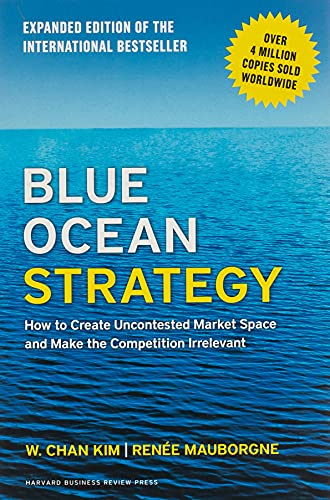I recently read the book “Blue Ocean Strategy” by W. Chan Kim and Renee Mauborgne as part of my master’s studies in innovation management. Although I had heard of the term “blue ocean” as a market strategy before, reading the book provided me with a deeper understanding. And I wanted to share my newfound knowledge with you. Enjoy your reading!
Traditionally, companies usually tend to try to beat the competition to be successful, by focusing on being the best within their industry, respecting the market boundaries, and focusing on the same customer group… Well, those days are over!!
In today’s business, in order to succeed in the game, you need to be innovative!!
The authors of “Blue Ocean Strategy” propose that instead of trying to outcompete established players in a saturated market, companies should focus on creating new market potential. This approach, known as a Blue Ocean strategy, increases the chances of success and profitability. In contrast, trying to enter an already crowded market is referred to as a Red Ocean strategy, where competition is fierce and market share is limited.
The book presents the results of a study of 108 businesses across 30 different industries. Of these, 92 companies employed a Red Ocean strategy of competing in saturated markets, while 16 companies adopted a Blue Ocean strategy by searching for new market fields. After looking for profit results for several years, The study found that over a period of several years, the 16 Blue Ocean companies generated 61% of total profits, while the 92 Red Ocean companies generated just 39%. These results demonstrate the advantage of a Blue Ocean strategy in terms of market dominance and profitability.
Let’s put the principles of the Blue Ocean Strategy to the test and see if it holds up in practice:
If you are American, you may be familiar with Southwest Airlines, a major airline company based in Dallas, Texas. The company transformed the short-haul airline industry by applying the concept of value innovation.

From the book “Blue Ocean Strategy”, page 78
In response to customer dissatisfaction with the trade-off between the affordability and flexibility of car transport and the speed of airplanes, Southwest Airlines developed a new business model that offered frequent flights with multiple departures and attractive prices. The company achieved this by eliminating or reducing traditional services provided by other airlines and incorporating car transport options. By operating with a low-cost model, Southwest Airlines was able to sail in a typical blue ocean and gain a competitive advantage over its rivals.
Now, let’s examine the strategic canvas of Southwest Airlines together:

From the book “Blue Ocean Strategy”, page 41
We can see that Southwest Airlines dropped some of the standard services offered by other airlines, such as different seating classes, hub connections, lounges, and meals, and instead focused on providing friendly service and frequent departures at a low cost.
By eliminating many additional services, Southwest Airlines was able to offer a low price that competitors cannot match.
Cirque du Soleil, one of Canada’s most successful cultural exports, is another example of a company that has successfully applied the principles of the Blue Ocean Strategy. Like Southwest Airlines, Cirque du Soleil reinvented the traditional circus by creating a unique value curve and focusing on key differentiators rather than trying to compete on all fronts.

From the book “Blue Ocean Strategy”, page 43
When comparing Cirque du Soleil with traditional circuses such as Ringling Bros and Barnum & Bailey (two of the big competitors at that time in the circus industry). We can see that all traditional circuses offered similar experiences for customers, with some small variations based on the resources available. However, Cirque du Soleil stands out with a distinct value curve, separating itself from the competition.
Cirque du Soleil eliminated traditional circus elements such as star performers, animal shows, aisle concessions sales, and multiple show arenas. In contrast, they added specific themes, a refined viewing environment, multiple productions, and artistic dance and music. These changes allowed them to charge higher prices and generate unique revenue streams.
In summary, in order to adopt a Blue Ocean Strategy like Southwest Airlines and Cirque du Soleil, companies should shift their focus away from competitors and instead investigate these four key questions:
1. What are the conventional factors in the industry that I should eliminate?
2. What factors should we reduce above the industry’s standard?
3. What factors should we raise below the industry’s standard?
4. What we can offer that industry have never offered yet?

From the book “Blue Ocean Strategy”, page 31
If you have any questions or insights about the topic, please share your thoughts with us in the comments or through the contact page.





